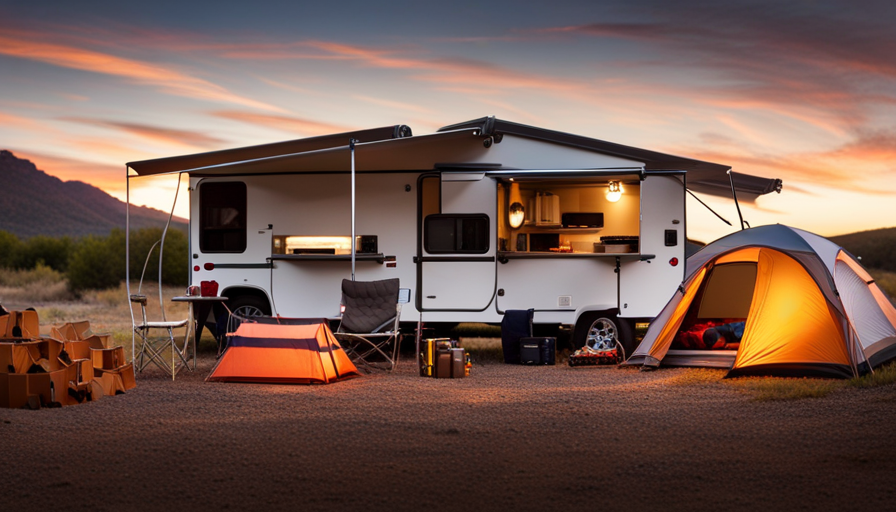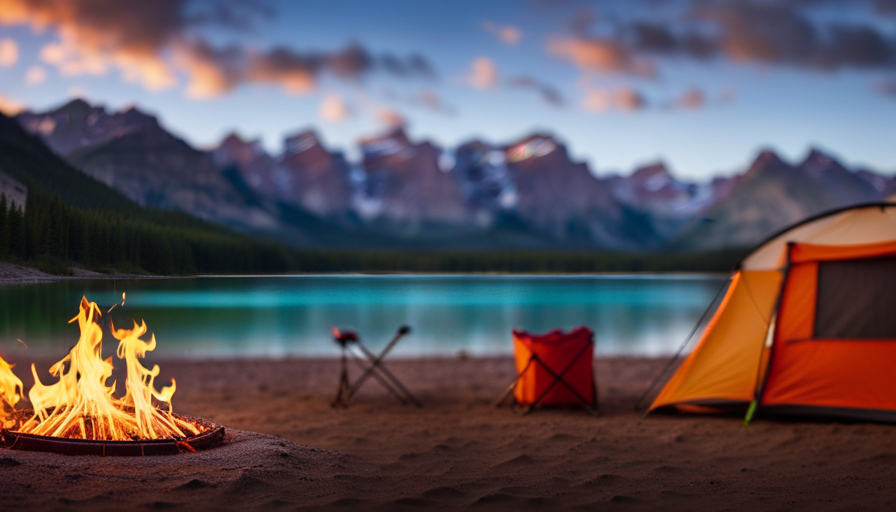Experiencing the soft touch of the breeze on my skin, the excitement of setting out on journeys on the open road with my dependable camper brings me immense happiness. Yet, as the camping season comes to an end, I am always confronted with the challenge of discovering a proper storage option for my beloved mobile home.
With so many options out there, it can be overwhelming to determine how much it will cost to store a camper. But fear not, fellow adventurers! I have delved into the world of camper storage and have all the information you need to make a well-informed decision.
In this article, I will explore the factors that affect the cost of camper storage, the different types of storage options available, and the average cost you can expect to pay. I will also provide tips on finding affordable storage solutions, as well as considerations for security and safety. If you’re feeling handy, I’ll even share some DIY storage ideas that won’t break the bank.
So, whether you’re looking for seasonal storage or a long-term solution, join me on this journey as we unravel the mysteries of camper storage and find the perfect place to keep our beloved travel companions safe until our next adventure begins.
Key Takeaways
- The cost of storing a camper can range from $30 to $200 per month, with variations based on location and amenities provided by the storage facility.
- Factors to consider when choosing camper storage include climate control and insurance coverage.
- There are different options for camper storage, including outdoor storage lots, covered storage facilities, and indoor storage units.
- When searching for affordable options, it is important to research and compare prices in different regions, consider sharing storage space with other camper owners, look for discounts or offseason storage deals, negotiate for the best deal, and consider storage facilities with additional amenities.
Factors Affecting the Cost of Camper Storage
Storing a camper can really add up, so it’s crucial to consider the factors that impact the cost. One of the main factors that affect the cost of camper storage is the average monthly cost. This can vary depending on the location and the amenities provided by the storage facility.
On average, camper storage can range from $30 to $200 per month. It’s important to note that climate controlled options tend to be more expensive due to the additional features that help protect your camper from extreme temperatures and humidity.
Climate controlled options are ideal for those who want to keep their camper in top condition, especially if they live in areas with harsh weather conditions. These storage units are equipped with temperature and humidity control systems to ensure that your camper is protected from any potential damage. While they may come at a higher cost, the peace of mind that comes with knowing your camper is safe and well-maintained is worth it.
Now that we’ve covered the factors affecting the cost, let’s move on to discussing the types of camper storage options available.
Types of Camper Storage Options
There are various options available for keeping your camper safe and secure. When it comes to camper storage, insurance coverage and climate control are two important factors to consider.
Insurance coverage ensures that your camper is protected in case of any unforeseen events or damage. It provides peace of mind knowing that you won’t have to bear the financial burden alone.
Climate control is another vital aspect to consider, especially if you live in an area with extreme weather conditions. This feature helps regulate the temperature and humidity levels inside the storage unit, preventing any potential damage to your camper due to moisture or extreme temperatures.
Whether you choose an outdoor storage lot, a covered storage facility, or an indoor storage unit, make sure to inquire about insurance options and climate control features.
Now, let’s move on to the next section, where we will discuss the average cost of camper storage.
Average Cost of Camper Storage
When considering the average cost of camper storage, it’s important to take into account national average prices, regional price variations, and any additional fees and charges that may apply.
The national average prices can give you a general idea of what to expect, but keep in mind that prices can vary greatly depending on your location.
Regional price variations can be influenced by factors such as demand, availability, and local competition.
Additionally, be aware of any additional fees and charges that may be associated with camper storage, such as security deposits or administrative fees.
National average prices
The national average prices for camper storage vary depending on the location and amenities provided. When it comes to storage costs, there are a few factors that can impact the price you’ll pay.
Firstly, regional price variations can play a significant role in determining the cost. For example, storage in urban areas tends to be more expensive compared to rural areas.
Additionally, the amenities offered at the storage facility can also affect the price. Some facilities may provide additional services such as security measures, climate control, and 24/7 access, which can increase the cost.
It’s also essential to consider insurance options for your camper while in storage, as this can provide peace of mind in case of any unforeseen events.
Now, let’s delve into the topic of regional price variations and explore how they can influence the overall cost of storing your camper.
Regional price variations
Now let’s uncover how regional price variations impact the overall cost of storing your camper.
Regional price comparisons play a significant role in determining how much you’ll pay to store your camper in different parts of the country. Prices can vary greatly depending on the location, with some areas being more expensive than others.
To save on costs, it’s essential to research and compare prices in different regions. Look for storage facilities that offer competitive rates and consider options that are slightly outside major cities or popular vacation destinations. These areas often have lower prices due to less demand.
Additionally, you can explore cost-saving strategies such as sharing storage space with other camper owners or taking advantage of off-peak seasons when prices may be lower. By being strategic, you can find ways to store your camper while keeping costs down.
Now, let’s delve into the topic of additional fees and charges.
Additional fees and charges
To avoid any surprises, be aware of the extra costs and charges that may come with storing your camper in different regions. Factors affecting pricing can vary depending on the location.
Some regions have higher demand for camper storage, leading to higher prices. Additionally, the cost of land and property taxes can also affect the pricing. Hidden costs may include security deposits, administration fees, or insurance requirements. It’s important to consider these factors when budgeting for camper storage.
To find affordable options, research different storage facilities in your desired region and compare prices. Look for facilities that offer competitive rates and transparent pricing. Consider the security measures in place and the accessibility of the facility. With careful consideration, you can find suitable and cost-effective storage for your camper.
Transitioning into the next section, let’s explore some tips for finding affordable camper storage.
Tips for Finding Affordable Camper Storage
Looking for ways to score a great deal on camper storage? Well, I’ve got some camper storage hacks and cost-saving strategies that will help you find affordable options.
First off, consider sharing a storage space with another camper owner. This way, you can split the cost and save some money.
Additionally, you can look for storage facilities that offer discounts for long-term rentals or offseason storage. Many places offer reduced rates during these periods, so take advantage of that.
Another tip is to compare prices from different storage facilities in your area. Don’t settle for the first one you find; shop around and negotiate for the best deal possible.
Furthermore, consider looking for storage facilities that offer additional amenities such as on-site maintenance or security features. These added benefits may increase the cost slightly, but they can provide peace of mind and save you money in the long run.
Additionally, make sure to inquire about any hidden fees or charges, such as insurance requirements or late payment penalties. Being aware of these potential costs upfront can help you avoid any surprises later on.
Now, let’s transition into the next section about security and safety considerations. It’s important to not only find affordable camper storage but also ensure that your camper is secure and protected while in storage.
Security and Safety Considerations
When it comes to storing your camper, there are several important security and safety considerations to keep in mind.
Firstly, it’s crucial to choose a storage facility that has proper security measures in place, such as 24-hour surveillance and gated access.
Additionally, exploring insurance options for your stored camper can provide added peace of mind in case of any unforeseen incidents.
Lastly, taking the time to properly maintain and prepare your camper before storing it can help prevent damage and ensure it’s ready to hit the road when you’re ready to use it again.
Security measures at storage facilities
Consider choosing a storage facility that has 24/7 video surveillance to ensure the safety of your camper; in fact, studies show that storage facilities with security cameras have a 73% lower chance of experiencing theft or vandalism. When it comes to security features, surveillance systems play a crucial role in deterring potential criminals and providing peace of mind for camper owners.
Here are three reasons why security cameras are essential at storage facilities:
-
Deterrence: Visible surveillance cameras act as a deterrent, making would-be thieves think twice before attempting any criminal activity.
-
Evidence: In the unfortunate event of theft or vandalism, video footage from surveillance cameras can provide crucial evidence to aid in identifying and apprehending the culprits.
-
Monitoring: With 24/7 video surveillance, storage facility staff can keep a constant eye on the premises, ensuring prompt response to any suspicious activity.
Considering these security measures, it’s important to also explore insurance options for stored campers.
Insurance options for stored campers
To ensure the safety of your stored camper, you’ll want to explore insurance options that provide peace of mind. Having insurance coverage for your camper while it’s in storage is crucial in protecting your investment against potential risks such as theft, vandalism, or damage caused by natural disasters. There are various insurance policies available specifically designed for stored campers, offering different levels of coverage and deductibles. It’s important to carefully review the policy details and understand the claim process before making a decision. To assist you in evaluating your options, here is a table that compares different insurance companies’ coverage and claim process:
| Insurance Company | Coverage | Claim Process |
|---|---|---|
| Company A | Comprehensive coverage for theft, vandalism, and natural disasters | Easy online claim process with 24/7 customer support |
| Company B | Basic coverage for theft and limited damage | Claim process requires documentation and inspection |
| Company C | Full coverage for all risks | Claims handled through local agents |
Considering the importance of insurance coverage, it’s also crucial to properly maintain and prepare your camper before storing it.
Maintenance and preparation tips before storing
When it comes to storing your camper, taking care of maintenance and preparation before storing is crucial to ensure its longevity and functionality. Here’s a maintenance checklist to help you get started:
-
Clean the interior and exterior thoroughly, including windows, floors, and surfaces.
-
Remove all perishable items and food to avoid attracting pests.
-
Check and clean the roof to prevent leaks and damage.
-
Ensure all appliances and systems are turned off and properly winterized.
By following this checklist, you can be confident that your camper is in good condition before storing it. Additionally, cleaning tips such as using mild detergent for cleaning and avoiding abrasive materials will help maintain the camper’s appearance.
Now that your camper’s ready for storage, the next step is choosing the right storage facility.
Choosing the Right Storage Facility
When it comes to choosing the right storage facility for your camper, there are several key points to consider.
Firstly, you’ll want to take into account the location and accessibility of the facility. It’s important to choose a facility that is convenient for you to access, especially if you plan on using your camper frequently.
Secondly, reading reviews and recommendations from other camper owners can provide valuable insights into the quality and security of the facility.
Lastly, consider the amenities and services provided by the facility, such as security features, maintenance options, and any additional perks that may enhance your storage experience.
Taking all of these factors into consideration will help ensure that you choose the right storage facility for your camper.
Location and accessibility
Located in a convenient area, storing a camper is a breeze with its easy accessibility. When considering the location analysis for a storage facility, proximity advantages play a crucial role. Here are five reasons why the location and accessibility of a storage facility are important:
-
Close to major highways: Easy access to major highways ensures a smooth and hassle-free journey to and from the storage facility.
-
Proximity to camping sites: Storing your camper near popular camping sites allows for quick and convenient retrieval when planning your next adventure.
-
Safety and security: Opting for a storage facility in a well-populated area adds an extra layer of security for your camper.
-
Local amenities: Having nearby amenities like gas stations, repair shops, and grocery stores makes it convenient to stock up and maintain your camper.
-
Peace of mind: Choosing a storage facility in a safe and accessible location provides peace of mind, knowing that your camper is in good hands.
With the location and accessibility factors taken care of, it’s time to delve into the next section about reviews and recommendations.
Reviews and recommendations
If you’re looking for some advice on finding the best storage facility for your camper, check out the reviews and recommendations from fellow outdoor enthusiasts. Reading reviews can give you a valuable insight into the experiences of other customers and help you make an informed decision.
Look for reviews that discuss the pricing comparison between different storage facilities, as this can help you find the most cost-effective option. Pay attention to customer experiences and any recurring issues mentioned in the reviews, as these can be red flags or positive indicators.
By taking the time to read through reviews and recommendations, you can gather valuable information that will ultimately help you find the best storage facility for your camper.
Now, let’s move on to the next section and explore the amenities and services provided.
Amenities and services provided
As you step into the world of storage facilities, a plethora of amenities and services await you, transforming your camper’s home-away-from-home into a sanctuary of convenience and comfort. These storage facilities offer an array of amenities to cater to your needs. From 24/7 access to your camper, climate-controlled units to protect it from extreme weather conditions, and on-site staff to assist you with any inquiries, these amenities ensure your camper remains safe and well-maintained. Additionally, most storage facilities prioritize security measures such as surveillance cameras, gated access, and individual unit alarms, giving you peace of mind while your camper is in storage. With these amenities and services, you can rest assured that your camper is in good hands. Now, let’s explore some DIY camper storage options.
DIY Camper Storage Options
Looking to store your camper? Check out these DIY options to keep your camper safe and organized.
When it comes to DIY camper organization, there are plenty of space-saving camper storage ideas that can help maximize your available space. One popular option is to use hanging organizers. These can be hung on the walls or doors of your camper and provide convenient storage for items like shoes, toiletries, and kitchen utensils.
Another great DIY idea is to use stackable bins or baskets. These can be easily stacked and stored under beds or in closets, keeping your belongings neat and tidy.
Additionally, utilizing storage nets or cargo nets can help secure larger items like camping chairs or outdoor equipment. These nets can be attached to the ceiling or walls of your camper, creating extra storage space.
Lastly, don’t forget about utilizing the space under your camper. You can install storage compartments or slide-out trays to store items like camping gear or tools. These DIY options are not only cost-effective but also customizable to fit your specific storage needs.
As you consider these space-saving solutions, it’s also important to keep in mind seasonal storage considerations.
[Transition sentence: Now let’s explore the factors to consider when storing your camper during different seasons.]Seasonal Storage Considerations
Little did you know, storing your beloved camper during different seasons can be quite the adventure. When it comes to seasonal storage considerations, there are a few important factors to keep in mind.
First and foremost, you want to ensure the security of your camper. This means taking proper security measures such as installing locks on doors and windows, and investing in a quality alarm system. Additionally, it’s crucial to review your insurance options and make sure your camper is adequately covered for any potential damages or theft that may occur while in storage.
During the winter months, it’s especially important to take extra precautions. Freezing temperatures can cause damage to the plumbing and electrical systems of your camper. Be sure to properly winterize your camper by draining all water and adding antifreeze to prevent any costly repairs come springtime.
As for the transition to long-term storage solutions, it’s essential to find a facility that offers secure and climate-controlled options. This will help protect your camper from extreme temperatures, pests, and other potential hazards. By taking the necessary precautions and investing in proper storage, you can ensure that your camper stays in great condition year-round.
Now, let’s explore the various long-term storage solutions available for your camper.
Long-Term Storage Solutions
Finding a reputable facility that offers secure and climate-controlled long-term storage options is crucial for ensuring the preservation and protection of your beloved camper. When considering long-term storage solutions, it’s important to prioritize the safety and security of your vehicle. Here are three key factors to consider when choosing a storage facility:
-
Security measures: Look for a facility that has reliable security measures in place, such as 24-hour surveillance, gated access, and on-site staff. This will help deter theft and vandalism, giving you peace of mind while your camper is in storage.
-
Climate-controlled environment: Extreme temperatures and humidity can cause damage to your camper over time. Opt for a storage facility that offers climate-controlled units to protect your vehicle from the elements and prevent issues like mold or rust.
-
Insurance options: While you may already have insurance for your camper, it’s a good idea to check if the storage facility offers additional insurance options. This can provide an extra layer of protection in case of any unforeseen events or damages.
By considering these factors, you can ensure that your camper is stored in a secure and controlled environment, minimizing the risk of damage or theft.
In the next section, we will discuss additional tips and resources to help you with the long-term storage of your camper.
Additional Tips and Resources
When it comes to storing a camper, there are a few additional factors to consider.
First, insurance considerations are important to ensure that your camper is protected in case of any damage or theft.
Next, it’s crucial to be aware of any legal requirements and permits that may be necessary for storing your camper, depending on your location.
Lastly, it’s always a good idea to practice proper camper storage etiquette and best practices to ensure a smooth and hassle-free experience.
Insurance considerations
One key factor to consider when insuring a camper is the peace of mind it can provide, knowing that you are protected in case of any unforeseen accidents or damages. Insurance coverage for campers typically includes protection against theft, natural disasters, and accidents. It’s important to carefully review the policy to understand the exact coverage you have and any limitations or exclusions. In the event of a claim, the process usually involves contacting your insurance provider, providing documentation of the incident, and working with their claims department to assess the damages and receive compensation. To give you an idea of the different coverage options available, here’s a table outlining some common insurance coverage types for campers:
| Coverage Type | Description |
|---|---|
| Liability Coverage | Protects against bodily injury or property damage you may cause to others |
| Comprehensive Coverage | Covers damages caused by non-collision incidents such as theft, vandalism, or weather events |
| Collision Coverage | Covers damages caused by collisions with other vehicles or objects |
| Personal Property Coverage | Protects your belongings inside the camper, such as furniture, appliances, and electronics |
Now, let’s move on to discussing the legal requirements and permits necessary for storing a camper.
Legal requirements and permits
To ensure compliance with legal regulations, it’s important to obtain the necessary permits and meet the requirements for storing your camper.
When it comes to filing requirements, it’s essential to research and understand the specific permits needed in your area. This may include obtaining a building permit if you plan to construct a storage facility on your property. Additionally, zoning regulations may dictate where you can store your camper, such as in a designated storage facility or on your own property.
It’s crucial to adhere to these regulations to avoid any legal issues or fines. Understanding the legal requirements and obtaining the necessary permits will help ensure that you are storing your camper in a legal and appropriate manner.
Moving forward, let’s explore camper storage etiquette and best practices for maintaining your camper in optimal condition.
Camper storage etiquette and best practices
Remember, you definitely don’t want to neglect your beloved home on wheels or risk the wrath of your neighbors by leaving it sitting idle and taking up valuable space. Proper camper storage organization is essential to keep your camper in good condition and make the most of the available space. One way to achieve this is by utilizing camper storage rental options. These facilities offer secure and convenient storage solutions, often providing amenities such as 24/7 access, surveillance cameras, and climate control, ensuring your camper remains safe and protected. Another option is to consider camper storage organizations that provide outdoor or covered storage spaces. These organizations often have designated areas for campers, making it easier for you to access and maintain your camper whenever needed. By utilizing these storage options and practices, you can ensure that your camper is well-maintained and ready for your next adventure.
| Benefits of Camper Storage Rental Options | Outdoor Storage Spaces | Covered Storage Spaces |
|---|---|---|
| Secure and convenient storage solutions | Accessibility | Protection from weather conditions |
| 24/7 access to your camper | Affordability | Increased security measures |
| Surveillance cameras for added security | Ample space for larger campers | Protection from dust and debris |
| Climate control to prevent damage | Easy maneuverability | Additional privacy |
Frequently Asked Questions
How much does it cost to store a camper for a short-term period, such as a few weeks or months?
When considering the cost of storing a camper for a short-term period, it’s important to compare different options.
There are various factors that can affect the cost, such as location, size of the camper, and amenities provided.
It’s worth exploring alternative options like RV parks, storage facilities, or even private property rentals.
By researching and comparing prices, you can find the most cost-effective solution that meets your needs and budget.
Are there any additional fees or charges that I should be aware of when storing my camper?
When it comes to storing your camper, it’s important to consider any additional storage fees that may apply. Some camper storage options may charge extra for services like security, maintenance, or access to facilities. It’s crucial to inquire about these potential charges upfront to avoid any surprises later on.
By being aware of any additional fees, you can make an informed decision and ensure that your camper is stored safely and securely.
Can I store my camper in a regular self-storage unit, or do I need a specialized facility?
You can store a camper in a regular self-storage unit, but it’s highly recommended to opt for a specialized facility. Specialized storage options are designed to cater specifically to the needs of campers, ensuring proper ventilation, security, and access.
These facilities often offer amenities like electrical hookups, dump stations, and on-site maintenance services. Storing your camper in a specialized facility provides peace of mind and convenience, making it a worthwhile investment.
Are there any restrictions on what I can store inside my camper while it is in storage?
There are typically restrictions on what you can store inside your camper while it’s in storage. Most storage facilities prohibit storing hazardous materials, flammable items, or perishable goods in your camper. It’s important to check with the specific storage facility for their list of prohibited items.
However, generally, you’re allowed to store non-perishable items, camping gear, and personal belongings inside your camper while it’s in storage.
How can I protect my camper from theft or damage while it is in storage?
To ensure the security of your camper while in storage, there are a few steps you can take. First, invest in a quality camper lock to deter potential thieves.
Additionally, consider installing a security system or motion sensor lights to further protect your camper.
It’s also important to have camper insurance to cover any potential damage or theft.
Remember, taking these precautions will give you peace of mind knowing that your camper is well-protected.
Conclusion
In conclusion, when it comes to storing your camper, there are various factors that can affect the cost. It’s important to consider the type of storage option you choose, as well as the location and amenities provided.
By doing some research and comparing prices, you can find affordable camper storage options that meet your needs. Keep in mind the importance of security and safety, and consider DIY storage options if they align with your skills and preferences.
Whether you need seasonal or long-term storage, there are solutions available to suit your needs.



















